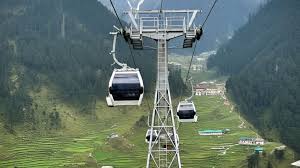Uttarakhand inks MoU with Swiss manufacturer for ropeway project

The Uttarakhand government has taken a major step to boost infrastructure and tourism by signing a Memorandum of Understanding (MoU) with Swiss ropeway manufacturer Bartholet Maschinenbau AG. This agreement sets the stage for an ambitious ropeway project that will link the sacred town of Rishikesh with the revered Kunjapuri Temple in Narendranagar. The project aims to improve connectivity, cut travel time, and promote sustainable tourism in one of India’s most beautiful and spiritual regions.
Enhancing Pilgrimage and Tourism Infrastructure
Uttarakhand is famous for its natural beauty and spiritual heritage, drawing millions of tourists and pilgrims each year. The Kunjapuri Temple, dedicated to Goddess Kunjapuri, sits atop a hill offering panoramic views of the Himalayas and the Ganges River. Traditionally, visitors reach this temple by a steep and time-consuming trek or a long road journey. These routes can prove difficult for elderly people and those with limited mobility.
The ropeway project will change this situation dramatically. It will offer a modern, efficient, and eco-friendly way to reach the temple. Once finished, the ropeway will cut travel time significantly. It will also provide a safe and comfortable journey through the stunning landscape.
Details of the MoU and Project Framework
The Uttarakhand government and Bartholet Maschinenbau AG signed the MoU on May 29, 2025. The project will run under a Public-Private Partnership (PPP) model. This model will use the Design-Build-Finance-Operate-Transfer (DBFOT) framework. It ensures private expertise and investment lead the project, while the state government supports regulation and long-term sustainability.
Bartholet will prepare the detailed project report (DPR) at its own expense. The DPR will cover technical, economic, and environmental assessments. This step will ensure the project meets global standards.
About Bartholet Maschinenbau AG
Bartholet Maschinenbau AG is a well-known Swiss company with decades of experience in building ropeways and cable cars worldwide. As part of the HTI Group, Bartholet offers innovative solutions that combine advanced technology, safety, and environmental care.
The company has previously worked on several ropeway projects in India. Their expertise suits the unique terrain and weather of the Himalayan region. This background makes Bartholet the perfect partner for Uttarakhand’s goal to modernize transport for pilgrims and tourists.
Benefits of the Ropeway Project
1. Improved Accessibility
The ropeway will improve access to Kunjapuri Temple, especially for senior citizens, differently-abled people, and families with children. It will eliminate the physical challenge of climbing steep paths and narrow roads.
2. Time Efficiency
Currently, the road trip to Kunjapuri Temple can take several hours, depending on traffic and weather. The ropeway will shorten this journey dramatically. Visitors will find it easier to plan their trips and visit more often.
3. Environmental Sustainability
Mountain roads face problems like landslides, soil erosion, and deforestation caused by heavy vehicle traffic. The ropeway will reduce the number of vehicles on these roads. This will lower carbon emissions, road congestion, and environmental damage. Ropeways also have a smaller ecological footprint, making them a greener choice for hilly areas.
4. Economic Growth and Employment
The project will boost local economies by attracting more tourists. This increase will create higher demand for hotels, shops, and transport services. Moreover, the construction and maintenance phases will generate jobs for local residents.
Alignment with Uttarakhand’s Tourism Vision
The Uttarakhand government prioritizes tourism infrastructure development to drive economic growth. It has launched projects such as the Char Dham highway, airport expansions, and new accommodations. These efforts aim to make the state a top choice for spiritual seekers and nature lovers.
The ropeway fits perfectly with this vision. It combines tradition with modern technology. The government wants to make religious sites more accessible while protecting the natural environment. This approach creates a model that can work well in other parts of the state.
Challenges and Considerations
The project holds great promise, but it faces some challenges:
- Environmental Clearances: Authorities must grant permissions while ensuring minimal harm to plants and animals.
- Community Engagement: Involving local people in planning will help address concerns about land use and livelihoods.
- Technical Adaptations: The ropeway must withstand harsh Himalayan weather, including heavy rains and snow.
- Affordability and Accessibility: Pricing should keep the ropeway affordable for average pilgrims, preventing exclusivity.
Future Prospects
With the MoU signed, the next steps include detailed planning, environmental studies, and consultations with stakeholders. Once the DPR receives approval, construction can begin. The ropeway could become operational within a few years.
If successful, this project may inspire more ropeways across Uttarakhand. Places like Haridwar, Mussoorie, and the Valley of Flowers could benefit from similar transport systems. These additions would further boost the state’s tourism appeal.
Conclusion
By signing the MoU with Bartholet Maschinenbau AG, Uttarakhand has set a new benchmark for tourism infrastructure. This project will offer pilgrims and tourists a safer, faster, and greener way to visit spiritual landmarks.
The ropeway represents a balance between heritage and innovation. It also reflects Uttarakhand’s commitment to sustainable development. As the state grows, such initiatives will help establish it as a world-class destination for pilgrimage and nature tourism.






